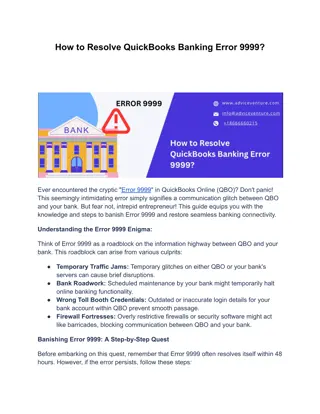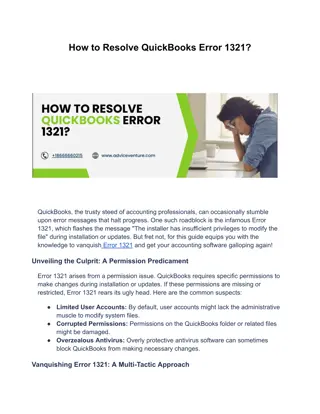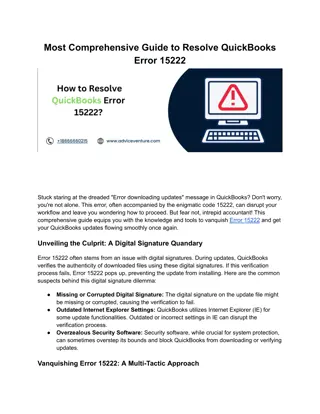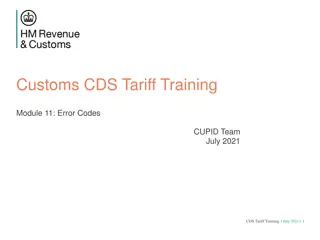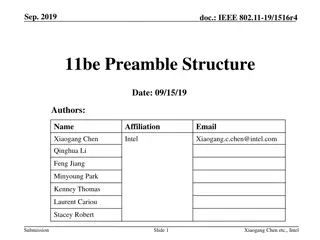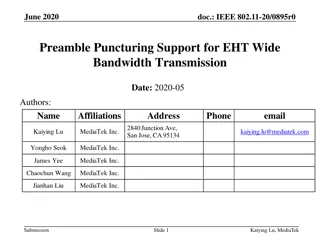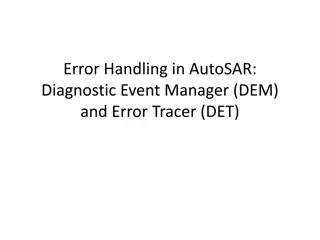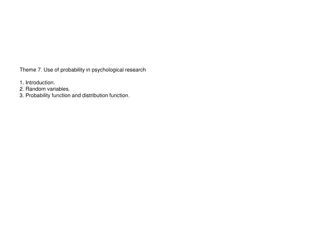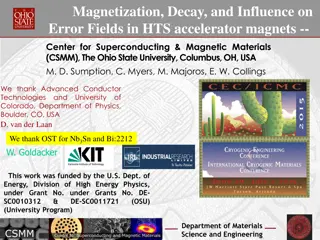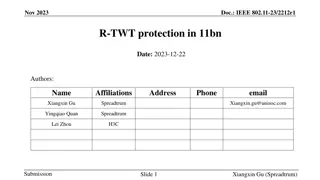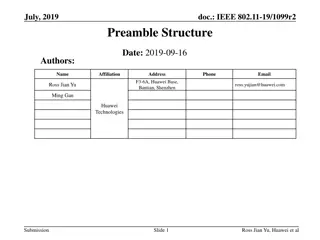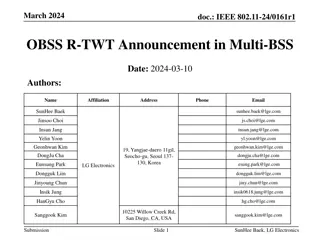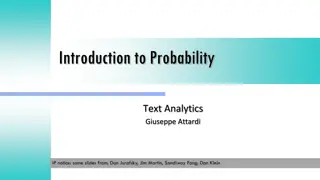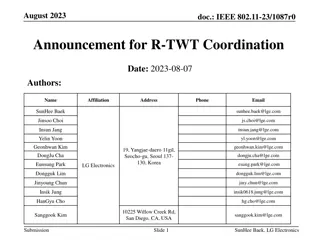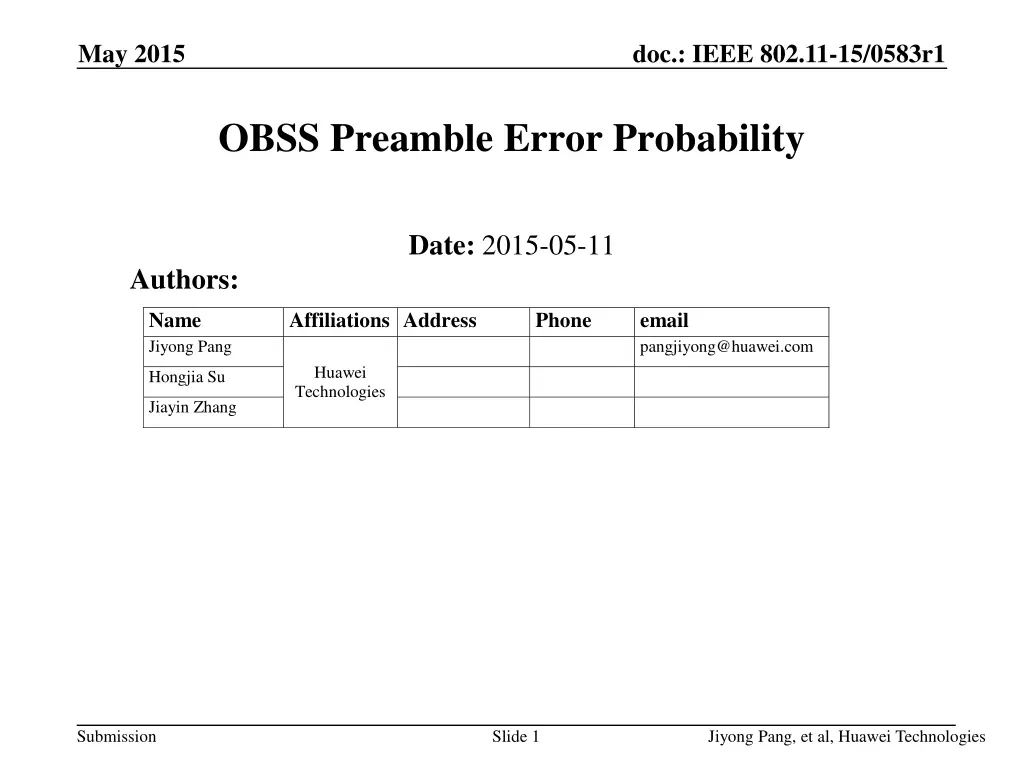
Understanding OBSS Preamble Error Probability in IEEE 802.11-15
Explore the impact of OBSS preamble error probability on network behavior in IEEE 802.11-15. This presentation discusses initial results, simulation scenarios, parameters, and preamble modeling related to OBSS preamble error detection. Gain insights into the factors influencing error probability in network simulations.
Download Presentation

Please find below an Image/Link to download the presentation.
The content on the website is provided AS IS for your information and personal use only. It may not be sold, licensed, or shared on other websites without obtaining consent from the author. If you encounter any issues during the download, it is possible that the publisher has removed the file from their server.
You are allowed to download the files provided on this website for personal or commercial use, subject to the condition that they are used lawfully. All files are the property of their respective owners.
The content on the website is provided AS IS for your information and personal use only. It may not be sold, licensed, or shared on other websites without obtaining consent from the author.
E N D
Presentation Transcript
May 2015 doc.: IEEE 802.11-15/0583r1 OBSS Preamble Error Probability Date: 2015-05-11 Authors: Name Jiyong Pang Affiliations Address Phone email pangjiyong@huawei.com Huawei Technologies Hongjia Su Jiayin Zhang Submission Slide 1 Jiyong Pang, et al, Huawei Technologies
May 2015 doc.: IEEE 802.11-15/0583r1 Background The OBSS preamble detection probability impacts much on the overall network behavior. [1, 2] showed that errors on OBSS preambles were very high around even 90% in both 11ax SS1 and SS2 [3] via MAC Simulator. In this presentation, we provide our initial results about the OBSS preamble error probability via Integrated Simulator where we find that the error probability is related closely to the simulation configuration. Submission Slide 2 Jiyong Pang, et al, Huawei Technologies
May 2015 doc.: IEEE 802.11-15/0583r1 Simulation Scenario 20MHz channel at 5G 1*1 antenna: 20dBm AP Tx power, 15dBm (-2dBi) STA Tx power Standard 11ax SS1 Residential 5 floor, 20 rooms per floor, 10 STAs per room Reuse 3 randomly Standard 11ax SS3 Indoor 19 BSSs, 30 STAs per BSS Standard 11ax SS4 Outdoor 19 BSSs, 50 STAs per BSS Submission Slide 3 Jiyong Pang, et al, Huawei Technologies
May 2015 doc.: IEEE 802.11-15/0583r1 Simulation Parameters PHY parameters Preamble model CCA-ED Rx sensitivity/CCA-SD Link Adaption Channel estimation PHY abstraction [4, 5] -62dBm/20MHz (measured after large-scale fading) -82dBm/20MHz (a packet with lower rx power is dropped) SINR feedback ideal RBIR, BCC MAC parameters Access protocol Queue length Traffic type MPDU size [EDCA, AC_BE with default parameters] [CWmin = 15, CWmax = 1023, AIFSn=3 ] A single queue for each traffic link is set inside AP/STA sized of 2000 packets UDP CBR with rate 10^8bps 1540 Bytes (1472 Data + 28 IP header + 40 MAC header) [A-MPDU / max aggregation size / BA window size, No A-MSDU, with immediate BA], Aggregation Max aggregation: 64 or 2 MPDUs with 4-byte MPDU delimiter 10 Disabled ON or OFF Max number of retries Beacon RTS/CTS Submission Slide 4 Jiyong Pang, et al, Huawei Technologies
May 2015 doc.: IEEE 802.11-15/0583r1 Preamble Model Signal Detect Preamble Error Detect Preamble PPDU The receiver will be locked by the first-arrived packet with signal strength above -82dBm, and later-arrived packets are considered as interference[4,5]. The receiver should be in IDLE status to detect an incoming preamble Preamble decoding modeled as a sub-frame decoding The packet length is calculated based on the assumption of 3-byte/4us (MCS0) Box0 PHY abstraction of SINR-to-PER is used [6] Preamble error% = 1-Total successfully decoded OBSS preambles/Total attempted decodes of OBSS preambles [2] Submission Slide 5 Jiyong Pang, et al, Huawei Technologies
May 2015 doc.: IEEE 802.11-15/0583r1 SS1 Error Probability 64MPDU 2MPDU RTS On RTS Off RTS On RTS Off SS1 DL & UL DL & UL DL Only UL Only DL & UL Error % 38.30% 55.89% 57.52% 87.33% 22.24% 81.96% 2MPDU 64MPDU Submission Slide 6 Jiyong Pang, et al, Huawei Technologies
May 2015 doc.: IEEE 802.11-15/0583r1 SS3 & SS4 Error Probability DL & UL RTS On Case SS3 SS4 64MPDU 27.69% 2MPDU 27.56% 64MPDU 16.21% 2MPDU 13.36% Error % SS4 SS3 Submission Slide 7 Jiyong Pang, et al, Huawei Technologies
May 2015 doc.: IEEE 802.11-15/0583r1 Observation Without RTS/CTS, the preamble error increases significantly. DL preamble could be more reliably detected than UL preamble. Aggregation level of MPDU also impacts the preamble detection. With RTS and short AMPDU, the preamble error in SS1 is low around 25%. With RTS, the preamble error does not depend much on AMPDU length in SS3 and SS4 and is low under 30% in SS3 and around 15% in SS4. Submission Slide 8 Jiyong Pang, et al, Huawei Technologies
May 2015 doc.: IEEE 802.11-15/0583r1 Summary We checked OBSS preamble error probability via our integrated SLS and we see that The error probability is not as much high as shown in [1,2] Error probability varies with different simulation cases Further observation will be get via more evaluation Further and thorough evaluation of this problem is required. Submission Slide 9 Jiyong Pang, et al, Huawei Technologies
May 2015 doc.: IEEE 802.11-15/0583r1 References [1] 11-14/1420r1 The Impact of Preamble Error on MAC System Performance [2] 11-15/0367r0 OBSS Preamble Detection [3] 11-14/0980r10 Simulation Scenarios [4] 11-14/1523r5 Offline Discussion Minutes of SLS Calibration [5] 11-14/0571r8 Evaluation Methodology [6] 11-14/1176r1 PHY abstraction tables for 11ax system level simulation Submission Slide 10 Jiyong Pang, et al, Huawei Technologies

